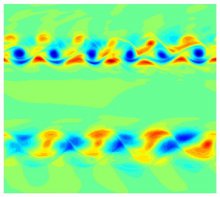We discuss a new mechanism that induces barotropic instability in the ocean. It is due to air-sea interaction with a quadratic drag law and horizontal viscous dissipation in the atmosphere. We show that the instability spreads to the atmosphere. The preferred spatial scale of the instability is that of the oceanic baroclinic Rossby radius of deformation. It can only be represented in numerical models, when the dynamics at this scale is resolved in the atmosphere and the ocean. The dynamics is studied using two superposed shallow-water layers, one for the ocean and one for the atmosphere. The interaction is due to the shear between the two layers.The shear applied to the ocean is calculated using the velocity difference between the ocean and the atmosphere and the quadratic drag law. In one-way interaction the shear applied to the atmosphere neglects the ocean dynamics, it is calculated using the atmospheric wind, only. In two-way interaction it is opposite to the shear applied to the ocean, respecting Newton’s third law. In the one-way interaction the atmospheric shear leads to a barotropic instability in the ocean. The instability in the ocean is amplified, in amplitude and scale, in two-way interaction and also triggers an instability in the atmosphere.





